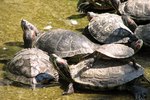
The world's largest living reptiles relish privacy and warm weather, and thrive in still or slow waters that provide plenty of camouflage. Fourteen species of crocodile live in temperate climates around the world, and as members of the crocodilian clan, they make their homes along sandy coasts, on muddy river banks and in salty mangrove swamps.
Warm Weather
Crocodiles inhabit every continent except Antarctica and Europe, according to the book "Crocodiles" by Sandy M. Walker. Cold-blooded, they flourish in tropical habitats where they can bask in the sun year-round. Some species, such as the American crocodile in the Florida Everglades, or the Indo-Pacific crocodile of Asia, bathe in salty swamps and brackish coastal waters. Most other crocodiles prefer freshwater rivers and ponds. Some make themselves at home in man-made water environments such as reservoirs, canals and ditches. Water provides relief from the heat and camouflage while hunting. Crocodiles prosper in wetland environments where they have a plentiful supply of turtles, frogs, fish, birds and mammals.
Burrow Habitat
American crocodiles dig burrow systems that provide an alternative refuge and resting place in case water levels are too low to offer cover. The entry to the burrow is usually camouflaged as it is built partly or completely underwater. The burrow may be quite shallow, perhaps only 2 feet below ground, according to the University of Michigan Museum of Zoology's Animal Diversity Web.
Nesting Habitat
The Morelet's crocodile, one of the smaller crocodile species, creates a floating habitat for its eggs. Using buoyant plant material, the crocodile provides a raft for her nest. Most other crocodile species choose to build nests on land and prefer elevated sites where they can build a mound or dig a hole. Nest spots on high ground keep eggs safe from water damage, but provide hatchlings quick access to water once they are born. In March, the female American crocodile begins to build her nest, using her back legs to dig holes up to 5 feet wide and 6 feet deep. In late April or early May, she will lay 30 to 60 eggs. Then she covers the eggs up with sand, soil and plant materials to keep them warm while they incubate.
Habitat Threatened
Historically, crocodiles were valued and hunted for their skin and meat. U.S. Fish and Wildlife designated the American crocodile an endangered species in the 1970s, but by 2007 the species had stabilized enough for its status to be downgraded to a "threatened" level. While poaching still exists, crocodiles now are protected by the Convention on International Trade in Endangered Species which prohibits their sale. Today, destruction of the crocodile's natural habitat for human use is one of the biggest threats to the survival of the species. As humans encroach on crocodile territory, nesting and hunting sites are shrinking. Construction takes over nesting areas and crocodiles sometimes wander into public areas such as golf courses and parks. Everglades National Park in Florida was created largely to protect the habitat of the American crocodile.
References
- University of Florida: American Crocodiles (Crocodylus Acutus) in Florida
- Animal Diversity Web: Crocodylus Acutus American Crocodile
- The Croc Docs: The American Crocodile: A Story of Recovery
- U.S. Fish and Wildlife Service: American Crocodile Crocodylus Acutus
- Crocodiles; Sally M. Walker
- Crocodiles: Their Ecology, Management, and Conservation; Crocodile Specialists Group of the IUCN
Photo Credits
-
Anup Shah/Photodisc/Getty Images
Writer Bio
Based in Los Angeles, Mary Helen Berg has been writing about pets, travel, families and parenting since 1989. Her work has appeared in publications such as "The Los Angeles Times" and "Newsweek." Berg holds a Master of Science from the Columbia University Graduate School of Journalism.



